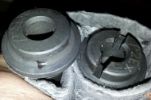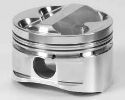I've just deleted the clutch line damper, wish I'd done it long ago.
The result is subtle but pleasing, I now feel more in touch with my clutch. The pedal has a 'springier' feel, and a more consistent action. I used to feel as if the clutch had a small amount of 'lag' in it's operation, which would have been acceptable if it had been consistent, but it wasn't, which made it hard to account for.
There were times when the clutch didn't react quite as I expected or wanted it to, sometimes engaging more or less heavily or lightly and / or more or less quickly than it should have, resulting in a lurch or excessive slippage. Sometimes it would result in a mistimed gear shift. None of this helped by a general feeling of 'numbness' in the pedal. The clutch has always just felt as if there was something a bit 'wrong' with it, in comparison to other clutches in other cars.
It's much nicer and more predictable with the damper deleted. However, it is rather subtle and I expect some people wouldn't really notice much difference, particularly people who make slow and deliberative gear shifts.
To delete the damper I just disconnected the two hard lines at the damper and cut the fittings off the ends. I then cut a short length of brass rod (about 3cm) with a suitably sized hole drilled through the length of it. Next step is to lead solder the two tubes into the brass connector tube. Strip off the plastic coating on the hard lines and abrade the surface down to clean metal before soldering. I used a 'grease' type soldering flux and simple electrical solder.
An acidic flux should work too, but I don't know how much would get left in the interior of the tubes nor how hard to clean out it may be nor whether it might react badly with the hydraulic fluid. A grease type flux just seemed likely to be more 'benign' if some were left in there. I flushed the tube through with hot water and then methylated spirits injected through with a large syringe, hopefully that got most of it, but I think I'll thoroughly re-bleed it in a few days.
I would normally silver solder a similar tubular joint, but cleaning the borax based flux out is an issue in this application. Be careful with the orientation of the tubes, try to bend the end of each one so that the alignment is reasonably close to correct before they are joined. There is some scope for bending / flexing so that the (now single) modified tube will fit and connect easily at each end, but only so much without becoming a pain.
I also cut away that part of the mounting bracket that holds the damper, just leaving the part that holds the end of the rubber clutch hose. This gives a bit more scope for 'shaping' the somewhat hard to bend hard lines.
I cut the damper open to see how it works, but can't really fathom it out, it doesn't look like it would do much (other than being a air trap). There are no springs, diaphragms, valves or other hardware inside that look like they would do anything significant, yet it must do something, somehow...
The result is subtle but pleasing, I now feel more in touch with my clutch. The pedal has a 'springier' feel, and a more consistent action. I used to feel as if the clutch had a small amount of 'lag' in it's operation, which would have been acceptable if it had been consistent, but it wasn't, which made it hard to account for.
There were times when the clutch didn't react quite as I expected or wanted it to, sometimes engaging more or less heavily or lightly and / or more or less quickly than it should have, resulting in a lurch or excessive slippage. Sometimes it would result in a mistimed gear shift. None of this helped by a general feeling of 'numbness' in the pedal. The clutch has always just felt as if there was something a bit 'wrong' with it, in comparison to other clutches in other cars.
It's much nicer and more predictable with the damper deleted. However, it is rather subtle and I expect some people wouldn't really notice much difference, particularly people who make slow and deliberative gear shifts.
To delete the damper I just disconnected the two hard lines at the damper and cut the fittings off the ends. I then cut a short length of brass rod (about 3cm) with a suitably sized hole drilled through the length of it. Next step is to lead solder the two tubes into the brass connector tube. Strip off the plastic coating on the hard lines and abrade the surface down to clean metal before soldering. I used a 'grease' type soldering flux and simple electrical solder.
An acidic flux should work too, but I don't know how much would get left in the interior of the tubes nor how hard to clean out it may be nor whether it might react badly with the hydraulic fluid. A grease type flux just seemed likely to be more 'benign' if some were left in there. I flushed the tube through with hot water and then methylated spirits injected through with a large syringe, hopefully that got most of it, but I think I'll thoroughly re-bleed it in a few days.
I would normally silver solder a similar tubular joint, but cleaning the borax based flux out is an issue in this application. Be careful with the orientation of the tubes, try to bend the end of each one so that the alignment is reasonably close to correct before they are joined. There is some scope for bending / flexing so that the (now single) modified tube will fit and connect easily at each end, but only so much without becoming a pain.
I also cut away that part of the mounting bracket that holds the damper, just leaving the part that holds the end of the rubber clutch hose. This gives a bit more scope for 'shaping' the somewhat hard to bend hard lines.
I cut the damper open to see how it works, but can't really fathom it out, it doesn't look like it would do much (other than being a air trap). There are no springs, diaphragms, valves or other hardware inside that look like they would do anything significant, yet it must do something, somehow...





















Comment